Southwell Union (Thurgarton Hundred Incorporation), Nottinghamshire
Up to 1834
A parish workhouse for 84 inmates was erected on the east side of Moor Lane (now Nottingham Road) in Southwell in 1808. It was designed by the Revd John T Becher in association with a local architect, believed to be Richard Ingleman. Becher published the plan of the workhouse in 1828 in his book The Anti-pauper System.
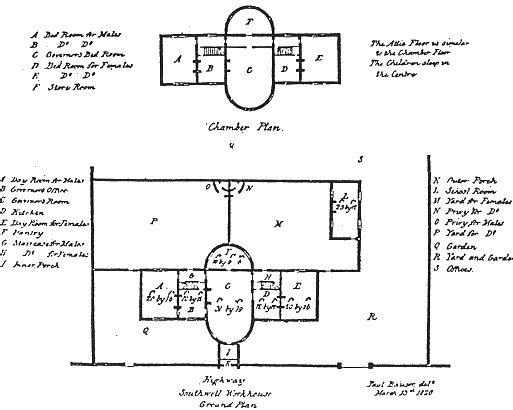
Southwell parish workhouse plan.
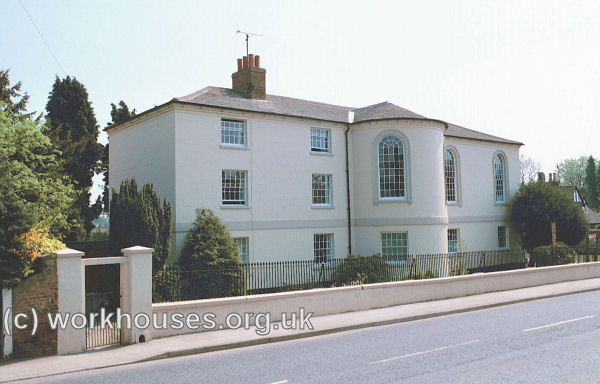
Former Southwell parish workhouse, 2001.
© Peter Higginbotham.
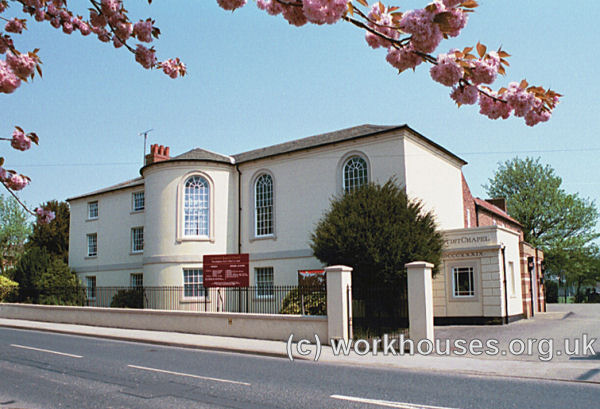
Former Southwell parish workhouse, 2001.
© Peter Higginbotham.
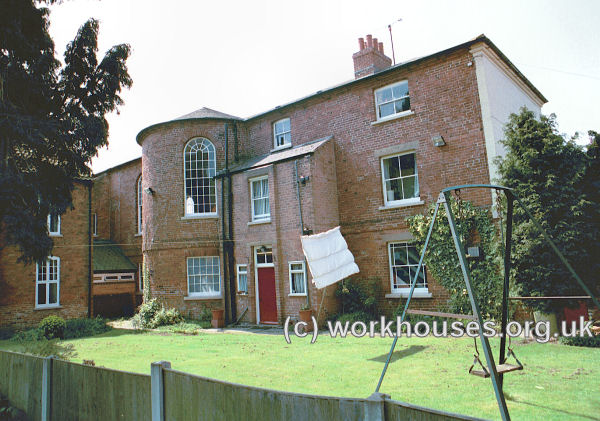
Former Southwell parish workhouse, 2001.
© Peter Higginbotham.
In an attempt to reduce the parish's escalating poor-rates bill, the provision of out-relief was abolished and the workhouse became the only form of relief on offer to the destitute. The regime in the workhouse was intended to deter any applicants who were not truly needy. Males, females and children were housed separately and not allowed to communicate with each other, or with friends outside. Inmates had to wear a workhouse uniform. Manual labour was required from the inmates, with women mostly occupied doing the domestic work of the establishment. Beer, tobacco and snuffed were barred, and the diet provided was plain and limited in quantity.
After the formation of the Southwell Poor Law Union in 1836, the building was converted into a Baptist chapel.
Southwell is also associated with the name of George Nicholls, a retired sea-captain then residing in the parish. Nicholls became an overseer for the parish between around 1821 and 1823. Nicholls, at Becher's behest, put into practice a system of poor relief recommended by Becher's cousin, the Revd Robert Lowe, who was the incumbent of the parish of Bingham near Nottingham. Lowe's strategy had been to virtually abolish out-relief and instead offer only a strictly and economically run workhouse. Nicholls applied the same principles at Southwell and reduced the parish's poor relief expenditure from £1,884 in 1821-2 to £811 in the following year. Nicholls left Southwell in 1823, but later made his mark as one of the new Poor Law Commissioners appointed after the passing of the 1834 Poor Law Amendment Act.
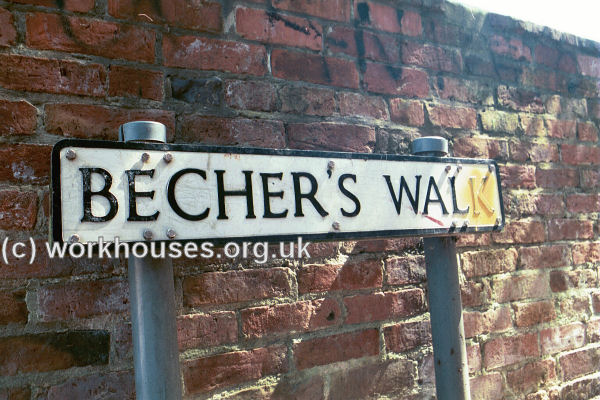
Becher's Walk, 2001.
© Peter Higginbotham.
In 1824, Becher promoted the formation of the Thurgarton Hundred Incorporation, a union of 49 parishes in the vicinity of (but not including) Southwell. Becher also had a hand in the design of a workhouse for the newly formed Incorporation although on this occasion, the associated architect was named as William Nicholson. As at Southwell, the Thurgarton Hundred operated a system based on strict economy and supervision tempered, as Becher put it, "with tenderness towards the Infirm and the Guiltless Poor, but opposing by every legal effort the overwhelming Advances of idle, profligate and sturdy pauperism." The workhouse segregated its inmates not only on the basis of sex, but also distinguished "paupers of good character and conduct" and those who were "idle, immoral, and improvident".
The Thurgarton Hundred Incorporation workhouse at Upton opened in December 1824. The new building cost £6,596 to construct and was much larger than the one at Southwell, accommodating up to 158 inmates. Its plan was also later published in The Anti-pauper System.
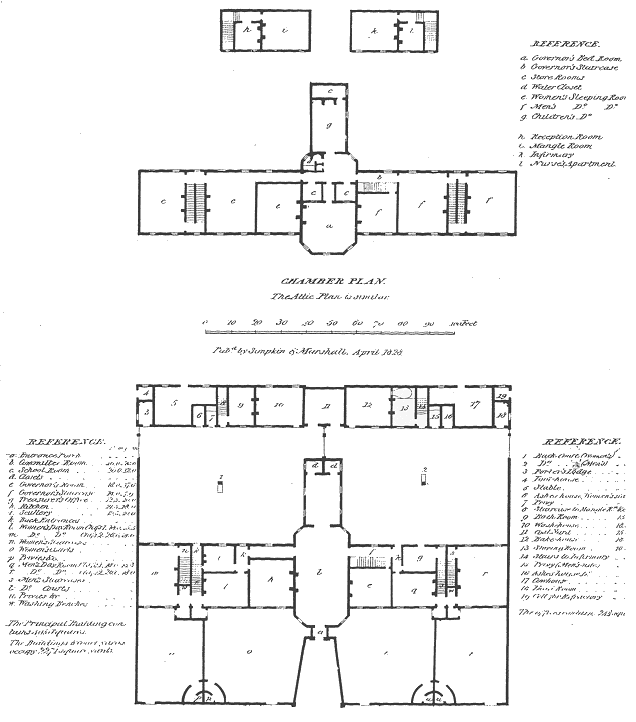
Thurgarton Incorporation workhouse plan.
The Southwell parish and Thurgarton Incorporation designs were characterized by wings emanating from a central hub, allowing various classes of inmate to be separated and supervised. This principle had originated in the 1780s in prison buildings and quickly began to become adopted by workhouse designers, for example in the buildings at Ongar which dates from around 1830, and at Stoke-on-Trent two years later. The "canted" corners of the Thurgarton Hundred workhouse's hub, which gave it an octagonal shape, were later to become a feature incorporated into the model workhouse plans published in 1835 by the Poor Law Commissioners. The PLC's designs were by a young architect called Sampson Kempthorne whose father was a friend of George Nicholls.
Ironically, the Thurgarton Incorporation workhouse, which was to have a significant influence on the shaping of the 1834 Poor Law Amendment Act, was actually operating illegally. The Incorporation, which was formed under the terms of Gilbert's Act of 1782, was only entitled to provide workhouse accommodation for the old and infirm, and for children, but not for the able-bodied.
After 1834
The Thurgarton Incorporation was, in principle, immune from the strictures of the 1834 Act. However, the Assistant Poor Law Commissioner responsible for Nottinghamshire, Edward Gulson, lobbied a number of local landowners including the Duke of Newcastle, Earl Manvers, Mr Denison MP, and Sir Robert Bromley. As a result, a sufficient number of the Incorporation's Guardians were persuaded that the Incorporation should be dissolved and replaced by a new Poor Law Union under the 1834 Act. The new union would include Southwell (whose name it would bear) and Upton where the existing Incorporation workhouse was located. In the run-up to the formation of the new Union, Gulson had visited Upton where he noted:
"...the great waste of fine bread, for which the hog-tub was the receptacle; on inquiry I found that no check of any kind was kept up as to the supply and consumption of provisions, and as this waste too surely proved, in this house of industry, avowedly the refuge for the idle, profligate or destitute, the inmates were fed to repletion."
Gulson also criticised the haphazard distribution of out-relief within the Incorporation. Inmates admitted to a workhouse who proved "too troublesome or turbulent to remain as inmates... were accordingly dismissed with a weekly allowance as the price of their disorderly conduct."
The new Southwell Poor Law Union was declared by the Poor Law Commissioners to take place from 25th April 1836. Its operation was overseen by an elected Board of Guardians, representing its 60 constituent parishes as listed below. (Each parish was represented by one Guardian, except Southwell which because of its size had three, thus making 62 Guardians in total.)
County of Nottingham: Averham, Bathley, Bilsthorpe, Bleasby, Boughton, Budby, Bulcote, Carlton-upon-Trent, Caunton, Caythorpe, Clipstone, Cromwell, Edingley, Edwinstow, Eakring, East Stroke, Egmanton, Elston, Epperstone, Farnsfield, Fiskerton, Gonaldstone [Gonalstone], Grassthorpe, Gunthorpe, Halam, Halloughton, Hockerton, Holme, Hoveringham, Kelham, Kersall, Kirklington, Kirton, Kneesall, Laxton with Moorhouse, Lowdham, Maplebeck, Morton, North Muskham, South Muskham, Norwell, Norwell Woodhouse, Ollerton, Ompton, Ossington, Oxton, Perlethorpe, Rolleston, Rufford, Southwell, Staythorpe, Sutton-on-Trent, Syerstone, Thorpe, Thurgarton, Upton, Walesby, Wellow, Weston, Winkbourn.
Later Addition: Park Leys (from 1858)
The population falling within the union at the 1831 census had been 23,235 — with parishes ranging in size from Staythorpe (population 61) to Southwell itself (3,384). The average annual poor-rate expenditure for the period 1832-35 had been £7,782 or 6s.8d. per head of the population.
The new Southwell Union adopted the former Hundred building as its Union workhouse. At its front was a three-storey building facing to the south-west, with three wings radiating from its elongated central hub. The hub contained a committee room and chapel on the ground floor, with the governor's bedroom and store-rooms above.
The women's wing to the west contained day-rooms and a kitchen on the ground floor, with dormitories above. The men's wing to the east had the governor's room and offices and mens' day rooms on the ground floor, again with dormitories on the upper floors. The shorter wing to the rear contained a school-room on the ground floor with children's dormitories above.
The site layout in 1898 is shown below.
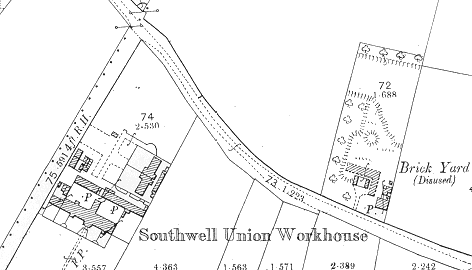
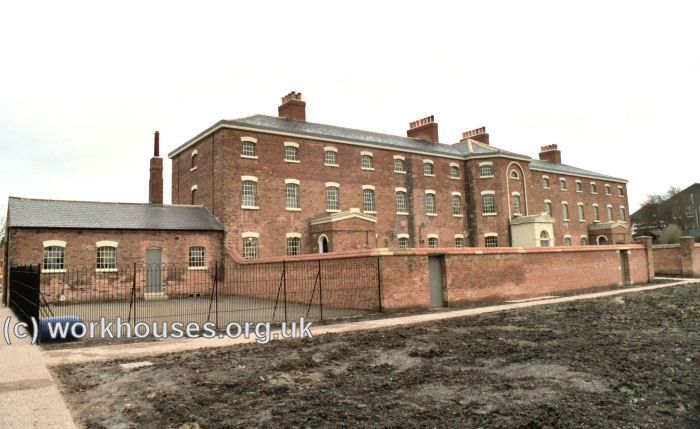
Southwell main block from the south-west, 2001.
© Peter Higginbotham.
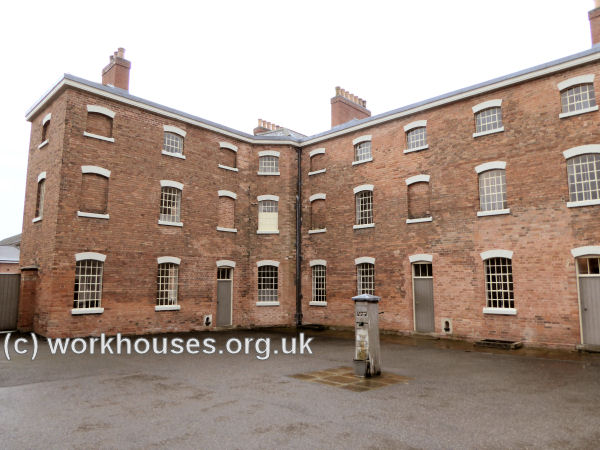
Southwell able-bodied women's yard from the north-west, 2001.
© Peter Higginbotham.
At the rear of the workhouse were two ranges of two-storey out-buildings. The west block (demolished sometime after 1915) contained the porter's lodge, wash-house and bathroom, privy, stable, ashes house and tool house. The east block contained a bakery, store-room, and small infirmary and nurse's room above. There were also a cowhouse, refractory (punishment) cell, and dead room (mortuary).
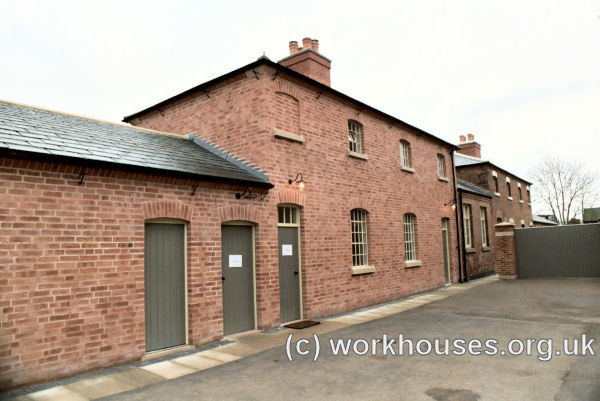
Southwell rear ranges from the south-west, after reconstruction in 2001.
The work performed by the inmates included stone-breaking, oakum picking, and bone-crushing, although the latter was discontinued following the Andover workhouse scandal in 1845. Inmates at Andover had been so hungry that they had resorted to fighting over the shreds of decaying meat left on the bones. Land in front of the workhouse at Southwell was also used for cultivating vegetables, with those surplus to the requirements of the kitchens being sold off.
Education in workhouses came partly under the remit of the Committee of Council on Education, whose inspectors made regular visits to workhouse schools. The Committee was also involved in the training and certification of teachers. They introduced a grading scale which had four main stages: Permission, Probation, Competency, and Efficiency, each stage having three sub-sections, numbered 1 to 3.
On 27th January, 1848, the Education Committee's Inspector for the East and Midlands region, Mr HG Bowyer, visited Southwell workhouse and found that 28 boys and 36 infants and girls were being taught. The school-master was Charles Spray (Efficiency Section 3 at a salary of £45 per annum) and the school-mistress Elizabeth Whitehead (Probation Section 2 at £20 per annum.) His report stated:
At a further visit on 4th June, 1850, Mr Bowyer, reported that 19 boys and 31 girls and infants were being taught in the workhouse, each group having separate schoolrooms. The school-master was still Charles Spray (now Effective Section 1 at £45 per annum) and the school-mistress was now Maria Richardson (Probation Section 2 at £20). The school's "Books and Apparatus" were listed as "Irish books and maps etc." The boys' school was "in its usual efficient condition" but the girls' school was noted as "unsatisfactory". However, a new school-room had just been built for the girls "so situated as to keep them from communication with the able-bodied women. This is a great improvement." Two or three of the boys were being taught shoe-making, while the rest were employed in the land belonging to the workhouse.
A year later, in August 1851, there were 18 boys and 15 girls and infants in the school. However, William Sumner (Probation Section 2 at £22.17s. per annum) had become the school-master, subsequently replaced by Thomas Driver (Probation Section 3 at £20 per annum). The schoolmistress was now Susan Thompson (Probation Section 1 at £21.2s. per annum). Mr Bowyer's observations on this occasion make interesting reading: "The cause of the compulsory resignation of the late master and mistress is a remarkable instance of the low tone of morality so frequently exhibited by the present race of workhouse teachers. She was old enough to have been his mother."
The concluding comment refers to the fact that 38-year-old Maria Richardson had become pregnant by William Sumner, seventeen years her junior.
In 1873, the workhouse Master, Mr Shaw, the Matron, Mrs Herring, and the workhouse nurse were forced to resign because of various "irregularities" in their conduct. Boards of Guardians were notoriously keen to avoid bad publicity so it is possible that the official reasons for the dismissals concealed rather more serious misdemeanours. Below is a press report from the time about the event.
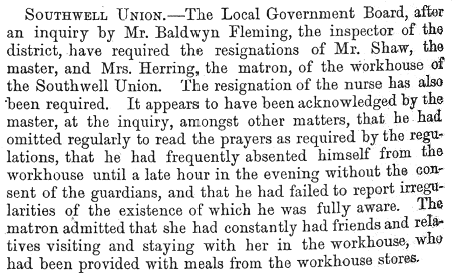
1873 News Report
Soon afterwards, the Guardians were advertising for a new Master and Matron.
MASTER AND MATRON WANTED
A detached infirmary was erected in 1870-1 at the rear of the workhouse, and was extended to the north in 1914. In 1926 a new infirmary block was added to the north.
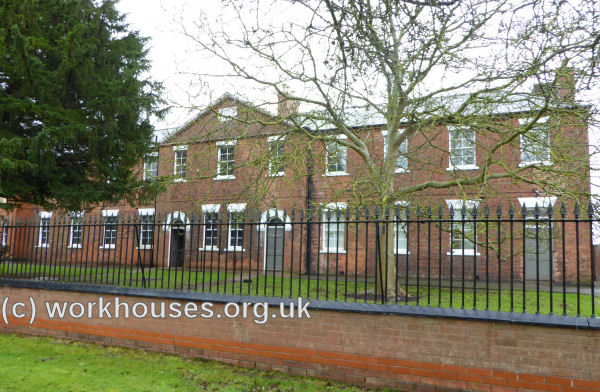
Southwell 1871 infirmary block from the west, 2001.
© Peter Higginbotham.
Southwell workhouse later became known as Greet House and provided residential accommodation for the elderly up until the 1980s. The former women's wing was in use as social services hostel accommodation until the same time.
The Southwell Union workhouse building is one of the most significant surviving workhouse buildings from the early nineteenth century. It has now owned by the National Trust who have restored the buildings to their original condition to allow visitors to experience what life was like back in the 1840s.
Staff
Inmates
Records
Note: many repositories impose a closure period of up to 100 years for records identifying individuals. Before travelling a long distance, always check that the records you want to consult will be available.
- Nottinghamshire Archives and Southwell Diocesan Record Office, County House, Castle Meadow Road, Nottingham NG2 1AG. Holdings include: Guardians' minute books (1836-1930); Ledgers (1836-1927, with gaps); Punishment book (1852-1936); Register of lunatics (1891-1928); Register of wool sales (1875-83); etc.
Bibliography
- The Anti-pauper System by Revd JT Becher (1828)
- In the Shadow of the Workhouse by Maurice Caplan (1984)
Links
- Southwell Union workhouse — the National Trust's project to restore this historic building.
- Southwell Union Correspondence (1834-1871) — now online at the National Archives.
- Southwell Baptist Church
Unless otherwise indicated, this page () is copyright Peter Higginbotham. Contents may not be reproduced without permission.


